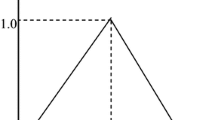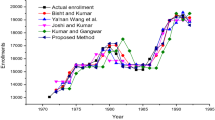Abstract
Intuitionistic fuzzy time series (IFTS) forecasting models have been proved more ideal than other forecasting models because of their efficient handling of non-stochastic uncertainties with non-determinism. It has also been shown by many researchers that interval length in both fuzzy time series (FTS) and IFTS plays a pivot role and affects accuracy in forecasting. In this paper, we propose a novel method to optimize interval length for enhancing accuracy in IFTS forecasting models. Proposed method optimizes interval length by minimizing mean square errors (MSEs). Objective function considered in this study is an interpolating polynomial which is calculated by Newton divided difference method. Performance and accuracy of proposed method is validated by comparing it with model of Kumar and Gangwar (IEEE Trans Fuzzy Syst 2015:2507582, [1]) and other previous existing FTS and IFTS forecasting models using time series data of University of Alabama enrollments.
Access this chapter
Tax calculation will be finalised at checkout
Purchases are for personal use only
Similar content being viewed by others
References
Kumar S, Gangwar S (2015) Intuitionistic fuzzy time series: an approach for handling non-determinism in time series forecasting. IEEE Trans Fuzzy Syst 2015:2507582
Song Q, Chissom BS (1993) Fuzzy time series and its models. Fuzzy Sets Syst 54:269–277
Song Q, Chissom BS (1993) Forecasting enrollments with fuzzy time series—Part I. Fuzzy Sets Syst 54:1–10
Zadeh LA (1965) Fuzzy set. Inform Control 8:338–353
Chen SM (1996) Forecasting enrollments based on fuzzy time-series. Fuzzy Sets Syst 81:311–319
Cheng C, Chang J, Yeh C (2006) Entropy-based and trapezoid fuzzification-based fuzzy time series approaches for forecasting IT project cost. Technol Forecast Soc Change 73:524–542
Huarng K (2001) Effective length of intervals to improve forecasting in fuzzy timeseries. Fuzzy Sets Syst 123:387–394
Huarng K, Yu THK (2006) The application of neural networks to forecast fuzzy time series. Physica A: Stat Mech Appl 363(2):481–491
Cheng CH, Cheng GW, Wang JW (2008) Multi-attribute fuzzy time series method based on fuzzy clustering. Exp Syst Appl 34:1235–1242
Egrioglu E, Aladag CH, Basaran MA, Uslu VR, Yolcu U (2009) (In press) A new approach based on the optimization of the length of intervals in fuzzy time series. J Intell Fuzzy Syst
Lee L-W, Wang L-H, Chen S-M (2008) Temperature prediction and TAIFEX forecasting based on high order fuzzy logical relationship and genetic simulated annealing techniques. Exp Syst Appl 34:328–336
Singh P, Borah B (2014) Forecasting stock index price based on M-factors fuzzy time series and particle swarm optimization. Int J Approx Reason 55(3):812–833
Chen SM, Phuong BDH (2017) Fuzzy time series forecasting based on optimal partitions of intervals and optimal weighting vectors. Knowl-Based Syst 118:204–216
Bisht K, Kumar S (2019) Intuitionistic fuzzy set based computational method for financial time series forecasting. Fuzzy Inform Eng 307–323
Atanassov K (1986) Intuitionistic fuzzy sets. Fuzzy Sets Syst 20:87–96
Atanassov K (1999). Intuitionistic fuzzy sets: theory and applications, Heidelberg, Germany: Physica-Verlag
Bas E, Yolcu U, Egrioglu E (2020) Intuitionistic fuzzy time series functions approach for time series forecasting. Gran Comput 1–11
Joshi BP, Kumar S (2012) Intuitionistic fuzzy sets based method for fuzzy time series forecasting. Cybern Syst 43:34–47
Kumar S, Gangwar S (2014) Probabilistic and Intuitionistic fuzzy sets-based method for fuzzy time series forecasting. Cybern Syst: Int J 45:349–361
Abhishekh, Gautam SS, Singh SR (2018) A score function-based method of forecasting using intuitionistic fuzzy time series. New Math Nat Comput 14(1):91–111
Wang YN, Lei Y, Fan X, Wang Y (2016) Intuitionistic fuzzy time series forecasting model based on intuitionistic fuzzy reasoning. Math Prob Eng
Lee HS, Chou MT (2004) Fuzzy forecasting based on fuzzy time series. Int J Comput Math 81:781–789
Qiu W, Liu X, Li H (2011) A generalized method for forecasting based on fuzzy time series. Exp Syst Appl 38:10446–10453
Yolcu U, Egrioglu E, Uslu VR, Basaran MA, Aladag CH (2009) A new approach for determining the length of intervals for fuzzy time series. Appl Soft Comput 9:647–651
Song Q, Chissom BS (1994) Forecasting enrollments with fuzzy time series—Part II. Fuzzy Sets Systems 62(1):1–8
Jurio A, Paternain D, Bustince H, Guerra H, Beliakov G (2010) A construction method of Atanassov’s intuitionistic fuzzy sets for image processing. Paper presented at the intelligent systems (IS), 5th IEEE international conference, 7–9 July 2010, London
Author information
Authors and Affiliations
Editor information
Editors and Affiliations
Rights and permissions
Copyright information
© 2021 The Author(s), under exclusive license to Springer Nature Singapore Pte Ltd.
About this paper
Cite this paper
Pant, M., Shukla, A.K., Kumar, S. (2021). A Novel Method to Optimize Interval Length for Intuitionistic Fuzzy Time Series. In: Tiwari, A., Ahuja, K., Yadav, A., Bansal, J.C., Deep, K., Nagar, A.K. (eds) Soft Computing for Problem Solving. Advances in Intelligent Systems and Computing, vol 1393. Springer, Singapore. https://doi.org/10.1007/978-981-16-2712-5_5
Download citation
DOI: https://doi.org/10.1007/978-981-16-2712-5_5
Published:
Publisher Name: Springer, Singapore
Print ISBN: 978-981-16-2711-8
Online ISBN: 978-981-16-2712-5
eBook Packages: Intelligent Technologies and RoboticsIntelligent Technologies and Robotics (R0)




